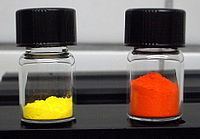Related compounds Molar mass 454.4 g/mol Melting point 259 °C Appearance orange-red powder | Formula HgI2 Density 6.36 g/cm³ Boiling point 350 °C | |
 | ||
Mercury ii iodide and thermochromism
Mercury(II) iodide (HgI2) is a chemical compound with an appearance of red-orange crystals. Unlike mercury(II) chloride it is hardly soluble in water (<100 ppm).
Contents
Conditions/substances to avoid include: heat, light, bromides, chlorides, ammonia, alkalis, cyanides, copper salts, lead salts, iodoform and hydrogen peroxide.
Properties
Mercury(II) iodide displays thermochromism; when heated above 126 °C, it undergoes phase transition from the alpha crystalline form to a pale yellow beta form. As the sample cools, it gradually reacquires its original color. It is often used for thermochromism demonstrations.
Production
Mercury(II) iodide is produced by adding an aqueous solution of potassium iodide to an aqueous solution of mercury(II) chloride with stirring; the precipitate is filtered off, washed and dried at 70 °C.
Uses
Mercury(II) iodide is used for preparation of Nessler's reagent, used for detection of presence of ammonia.
Mercury(II) iodide is a semiconductor material, used in some x-ray and gamma ray detection and imaging devices operating at room temperatures.
Mercury(II) iodide can be found extremely rarely in nature as mineral coccinite.
In veterinary medicine, mercury(II) iodide is used in blister ointments in exostoses, bursal enlargement, etc.
It can appear as a precipitate in many reactions.
